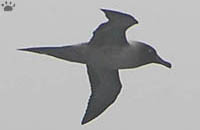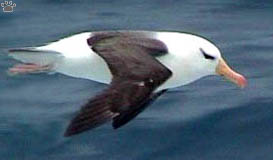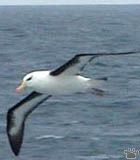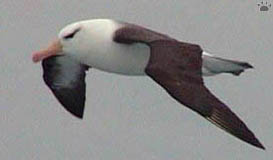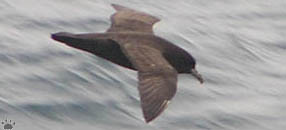|
Other Seabirds.
In addition to penguins, at least seventy other species of seabirds
can be seen in Scotia Sea at least occasionally;
about half of them breed here. The most numerous are small bluish-grey
birds called Antarctic prion, also called
Dove Prion, Pachyptila desolata, and Blue Petrell, Halobaena
caerulea, South of the Antarctic Convergence,
you can usually see hundreds of them flying around at any given time.
The writer of the original version of
those pages, does not have any pictures of them, because their fast,
irregular flight
makes them almost impossible to photograph unless you get to their
breeding grounds. Most seabird colonies in the
area are off-limits to visitors coming by cruise ships: landings usually
occur on protected beaches, while smaller seabirds
nest in burrows on grassy slopes, and albatrosses
need steep hills where strong winds allow them to take off easily
.
 Antarctic
prion, also called Dove Prion, Pachyptila desolata,
Photo:
© Tony Palliser
Antarctic
prion, also called Dove Prion, Pachyptila desolata,
Photo:
© Tony Palliser
The
Antarctic Prion,
Pachyptila desolata
is a member of the Pachyptila genus, and along with the
Blue Petrel, Halobaena caerulea, makes up the Prions.
They in turn are members of the Procellariidae family, and the
Procellariiformes order.
The prions are small and typically eat just zooplankton; however
as a member of the Procellariiformes, they share certain identifying
features. First, they have nasal passages that attach to the
upper bill called naricorns.
Although the nostrils on the Prion are on top of the upper bill.
The bills of Procellariiformes are also unique in that they
are split into between 7 and 9 horny plates. They produce a
stomach oil made up of wax esters and triglycerides that is
stored in the proventriculus. This is used against predators
as well as an energy rich food source for chicks and for the
adults during their long flights. Finally, they also have a
salt gland that is situated above the nasal passage and helps
desalinate their bodies, due to the high amount of ocean water
that they imbibe.
It excretes a high saline solution from their nose.
The Antarctic Prion, Pachyptila desolata, also known as the
Dove Prion, or Totorore in Maori, is the largest
of the prions, a genus of small petrels of the Southern Ocean.
Pachyptila, the word, comes from the Greek words pakhus
and ptilon. Pakhus means thick or stout and ptilon means a feather.
Desolatus is Latin for forsaken or desolate. This is in reference
to the desolate Antarctic region where they live. Also from
the Greek language, Prion comes from the word prion meaning
a saw, which is in reference to its serrated edges of its bill.
The wingspan is 17 to 20 cm (6.7 to 7.9 in),[7] while the body
length is 28 cm (11 in).[6] Like all prions, its underparts
are white and upperparts are blue-grey, with a dark "M"
across its back to its wingtips. It has a white eyebrow, blue-grey
bill, and blue feet. It also has a grey wedge-shaped tail with
a black tip. On its wings, its greater coverts are near black.[8]
Source: http://en.wikipedia.org/wiki/Antarctic_Prion

South
Georgia, March,
2006
Photo: © Mike Danzenbaker http://avesphoto.com/website/AO/species/PETBLU-1.htm
The Blue Petrel, Halobaena caerulea, is a small seabird.
This small petrel is the only member of the genus Halobaena
but is closely allied to the prions.
The Blue Petrel's plumage is white underneath and grey on its
upper parts, with an "M" banding across its top, which
is similar to the prion's. It also has a white-tipped tail.
Its bill is smaller than prions.
They feed predominantly on krill, as well as other crustaceans,
fish, and squid. They can dive up to at 6 m (20 ft).
Source: http://en.wikipedia.org/wiki/Blue_Petrel
|
 |
 |
 |
Wandering
albatross, Diomedea exulans, has the largest
wingspan of all living birds: up to 3.6 m/12'.
About 4,000 pairs breed on South Georgia. Burdwood Bank, Scotia
Sea.
|

Grey-headed
albatross near breeding grounds,
Elsehul,
South Georgia. |
The most common albatross in the area is
the black-browed
albatross,
Diomedea (Thalassarche) melanophris, with almost half
a million pairs on the Falklands and 60,000 pairs on South
Georgia. Grey-headed albatross, Diomedea (Thalassarche)
chrysostoma, is less numerous,
with less than 40,000 pairs on South Georgia and 20,000 on
Diego Ramirez islands south of Cape Horn. Each species has
its own migration
patterns. Wandering albatrosses are believed to fly around
the Antarctic after each breeding season, making up to 50
flights around the globe in their lifetime. Albatrosses feed
on whatever they can snatch from surface, although black-browed
albatross prefers krill and fish, while others feed mostly
on squid. All albatrosses are now under threat: many birds
are accidentally
killed by fishing operations.
|

Grey-headed
and black-browed
albatrosses,
Elsehul,
South Georgia. |

Thalassarche
chrysostoma
Photo: Ben Phalan,
British Antarctic Survey
The Grey-headed Albatross, Thalassarche chrysostoma,
also known as the Grey-headed Mollymawk, is a large seabird
from the albatross
family. It has a circumpolar distribution, nesting on isolated
islands in the Southern Ocean and feeding at high latitudes,
further south than any of the other mollymawks. Its name derives
from its ashy-grey head, throat and upper neck.
The meaning of the name chrysostoma is derived from two Greek
words. Khrusos' means gold and stoma means the mouth, in reference
to its golden bill.
The Grey-headed Albatross averages 81 cm (32 in) in length
and 2.2 m (7.2 ft) in wingspan. Weight can range from 2.8
to 4.4 kg (6.2 to 9.7 lb), with a mean mass of 3.65 kg (8.0
lb). It has a dark ashy-grey head, throat, and upper neck,
and its upper wings, mantle, and tail, are almost black. It
has a white rump, underparts, and a white crescent behind
its eyes. Its bill is black, with bright yellow upper and
lower ridges, thatt shades to pink-orange at the tip.
Source: http://en.wikipedia.org/wiki/Grey-headed_Albatross |

Light-mantled
albatross building a nest.
Hills above Grytviken, South Georgia. |
Probably the most beautiful seabird of the
Southern Ocean is the light-mantled
albatross
Phoebetria palpebrata
. These long-tailed, narrow-winged birds nest on steep, often
rocky, slopes. Their breeding season starts later than in
most other seabirds, sometimes in late summer. Less than 8,000
pairs breed on South Georgia. |

Courtship
flight of light-mantled albatrosses.
Hills above Grytviken, South Georgia. |

Antarctic
or Southern giant petrels, Macronectes giganteus, Northern
giant or Hall's Giant petrels, Macronectes halli,
and one white-chinned petrel, Procellaria aequinoctialis,
Elsehul, South Georgia. |

Antarctic
or Southern giant petrel. These birds have more universal airframe
than albatrosses: they are not as good at gliding, but are less
dependent on wind. Ushuaia,
Tierra del Fuego. . |

Dark phase
of Antarctic
or Southern giant petrel,
Elsehul, Syd Georgia. |
Giant petrels are the vultures of the Southern
Ocean. They feed on carrion; males also kill small birds,
while female are better at catching squid and fish. Both species
have variable coloration. Northern giant petrel, with pink
bill tip, is less common, with just 3,000 pairs on South Georgia.
Southern giant petrel is more numerous and widespread; some
birds in the far South are almost pure white. Both species
are highly migratory,
and sometimes form mixed colonies, but Northern giant petrel
starts breeding much earlier (late September rather than November). |

White phase
of Antarctic
or Southern giant petrel,
off South Orkney Islands |

Antarctic
or Southern Giant petrell
Drake Passage. |

Both species
of giant petrels,
Drake Passage. |

Hall's or
Northern giant petrel,
Gold Harbour, South Georgia |
 Giant
petrel with chicks, Macronectes giganteus, January
1999
Note
the tip of the bill - the green colour which differ it from
the Northern specimen.
Photo: Mila Zinkova,
http://en.wikipedia.org/wiki/File:Giant_petrel_with_chicks.jpg
Giant
petrel with chicks, Macronectes giganteus, January
1999
Note
the tip of the bill - the green colour which differ it from
the Northern specimen.
Photo: Mila Zinkova,
http://en.wikipedia.org/wiki/File:Giant_petrel_with_chicks.jpg
The Southern Giant Petrel, Macronectes giganteus, also
known as the Antarctic Giant Petrel, Giant Fulmar, Stinker,
and Stinkpot, is a large seabird of the southern oceans. Its
distribution overlaps broadly with the similar Northern Giant
Petrel, though it overall is centered slightly further south.
Adults of the two species can be separated by the colour of
their bill-tip: greenish in the Southern and reddish in the
Northern
Macronectes giganteus can be broken down as makros
a Greek word meaning long or large and nektes meaning
swimmer, and giganteus from the Latin for gigantic.
Southern Giant Petrel starts with southern referring to their
habitat being further south than their counterpart the Northern
Giant Petrel, and Petrel refers to St. Peter and from
the story of him walking on water, which refers to how they
run on top of the water as they are getting airborne.
This petrel is the largest of the Procellariidae and measures
86–99 cm (34–39 in) with a wingspan of 185–205
cm (73–81 in). The male weighs approximately 5 kg (11
lb) and the female 3–8 kg (6.6–18 lb).
They have a very large yellow bill, with a green tip and greyish-brown
legs
Source: http://en.wikipedia.org/wiki/Southern_Giant_Petrel

A Northern
Giant Petrel on Salisbury Plain, South Georgia
Note
the tip of the bill - the brown colour which differ it from
the Southern specimen.
Source: http://en.wikipedia.org/wiki/File:Macronectes_halli_-Salisbury_Plain,_South_Georgia,_British_Overseas_Territories,_UK-8.jpg
The Northern Giant
Petrel, Macronectes halli, also known as the Hall's
Giant Petrel, is a large seabird of the southern oceans. Its
distribution overlaps broadly with the similar Southern Giant
Petrel, though it overall is centered slightly further north.
The Northern Giant Petrel averages 90 cm (35 in) in length.
Its plumage consists of grey-brown body with lighter coloured
forehead, sides of face, and chin. Its bill is between 90–105
mm (3.5–4.1 in) long and is pinkish yellow with a brown
tip, and its eyes are grey. The juvenile of this species is
completely dark brown and lightens as it ages. It can be differentiated
from the similar coloured Southern Giant Petrel by the top
of the bill, which on the southern is green.
The Northern Giant Petrel feeds mainly on carrion from penguins
and pinniped, as well as krill, offal, cephalopods, and discarded
fish and waste from ships.
Source: http://en.wikipedia.org/wiki/Northern_Giant_Petrel |

Southern fulmar, Fulmarus glacialoides,
off South Orkney Is. |
Numerous other species of petrels, fulmars,
shearwaters, prions, diving-petrels and storm-petrels inhabit
the islands of the Scotia Sea. The most abundant is Antarctic
prion (P. desolata), with 20-30 million pairs on South
Georgia alone. All these birds lay only one egg; smaller species
usually nest in burrows. On the Falklands, Tierra del Fuego
and South Georgia, many are now extinct or rare on main islands
because of predation by introduced rats and other mammals,
but still breed in huge numbers on offshore islets.
|

Southern
fulmar,
Fulmarus glacialoides,
off South Orkney Is. |

Southern
Fulmar
Photo ©
Samuel Blanc, http://www.sblanc.com/
The Southern Fulmar, Fulmarus glacialoides, is
a seabird of the Southern Hemisphere. Along with the Northern
Fulmar, Fulmarus glacialis, it belongs to the fulmar
genus Fulmarus in the family Procellariidae, the true petrels.
It is also known as the Antarctic Fulmar or Silver-grey Fulmar.
It is largely pale grey above and white below with a distinctive
white patch on the wing. It breeds on the coast of Antarctica
and on surrounding islands, moving north in winter. It nests
in colonies on cliffs, laying a single egg on a ledge or crevice.
Its diet includes krill, fish and squid picked from the water's
surface.
It is a fairly large, bulky petrel, 45–50 cm (18–20
in) long with a wingspan of 110–120 cm (43–47 in).
The male has an average weight of 7.95 kg (280 oz) while the
smaller female weighs around 7.40 kg (261 oz). These weights
increase to 10.5 and 9.32 kg (370 and 329 oz) at the start
of a shift incubating the eggs.
The male has a wing length of 34 cm (13 in), bill length of
44.6 mm (1.76 in)
At sea, it mainly occurs along the outer edge of the pack
ice in summer with water temperatures of -1.5 to 0.5°C.
In winter, it regularly ranges north to around 40°S. It
occurs further north in the cool waters of the Humboldt Current,
reaching Peru. Small numbers are seen off the coasts of South
Africa, southern Australia and New Zealand.
Source: http://en.wikipedia.org/wiki/Southern_Fulmar
|
 |
|
 |
White-chinned
petrels, Elsehul, Syd Georgia.
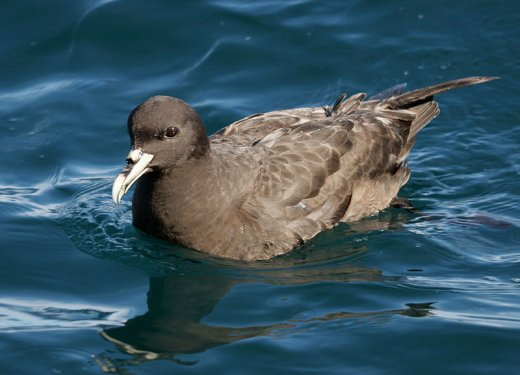 White-chinned
petrel off Kaikoura, 26 February 2007
White-chinned
petrel off Kaikoura, 26 February 2007
Photo: Mjobling, http://en.wikipedia.org/wiki/File:070226_White-chinned_petrel_off_Kaikoura_1.jpg
The White-chinned Petrel or Cape Hen, Procellaria
aequinoctialis, is a large shearwater in the family
Procellariidae.
It ranges around the Southern Oceans as far north as South
Australia, Peru and Namibia,
and breeds colonially on scattered islands
Procellaria comes from two Latin words, procella
meaning a storm and arius a suffix meaning pertaining
to.
This is in reference to their association with stormy weather.
The word Petrel is derived from St. Peter and the
story of his walking on water. This is in reference to the
Petrels habit of appearing to run on the water to take off.
The White-chinned Petrel measures 51–58 cm (20–23
in) in length, weighs 0.97–1.89 kg (2.1–4.2 lb)
and spans 134–147 cm (53–58 in) across the wings.
Not only is it the largest Procellaria petrel but is also
the largest species in its family outside of the giant petrels.
This large petrel is sooty-black and has some white on its
throat and chin.
Source: http://en.wikipedia.org/wiki/White-chinned_Petrel
|
 |
 |
|
|
 |
|
|
Cape
petrel,
Daption capense,
off Elephant Island,
South Shetland Is.
|
Snow
petrels, Pagodroma nivea,
off Antarctic Peninsula.
|
At
34-45 g, Wilson's storm petrels, Oceanites oceanicus,
are the
smallest seabirds in the Southern Ocean. But they calmly feed
even
during the fiercest storms, and migrate
all over the world's oceans.
They have good sense of smell, and feed on krill, tiny fish
and squid.
|

A
Cape Petrel flying near Clarence Island, Southern Ocean, January
2011
Soource: http://en.wikipedia.org/wiki/File:Daption_capense_-near_Clarence_Island,_Southern_Ocean_-flying-8_(2).jpg
The Cape Petrel, Daption capense, also called Cape Pigeon
or Pintado Petrel, is a common seabird of the Southern Ocean
from the family Procellariidae.
It is the only member of the genus Daption, and is allied
to the fulmarine petrels, and the Giant Petrels. It is also
sometimes known as the Cape Fulmar. They are extremely common
seabirds with an estimated population of around 2 million
The Cape Petrel is a unique looking Petrel. It has a black
head and neck, and a white belly, breast, and its underwing
is white with a black border. Its back, and upperwings are
black and white speckled, as is its tail which also has a
band of black. When fully grown, their wings span 86 cm (34
in) and they are 39 cm (15 in) long
Source: http://en.wikipedia.org/wiki/Cape_Petrel

Snow
Petrel (Pagodroma nivea
Photo: Samuel Blanc, http://www.sblanc.com/
The
Snow Petrel, Pagodroma nivea, is the only member
of the genus Pagodroma. It is one of only three birds that
breed exclusively in Antarctica and has been seen at the South
Pole. It has the most southerly breeding distribution of any
bird
The Snow Petrel, Pagodroma nivea, is a small, pure white fulmarine
petrel with black underdown, coal-black
eyes, small black bill and bluish gray feet.[8] Body length
is 36–41 cm (14–16 in) and the wingspan is 76–79
cm (30–31 in). Flight is more fluttering than most petrels.
They are known to live 14 to 20 years.
Breeding occurs in colonies on the Antarctic Peninsula, and
various Antarctic islands.[6] Nesting is colonial in
small to large colonies on cliffs, usually near the sea, but
also inland. Only very rarely are they observed north
of
the pack ice.
http://en.wikipedia.org/wiki/Snow_Petrel

Karnataka
Pelagic Udupi, Oct off Malpe coast shot around 50kms from
coast.
Shows the Yellow webbet feet of the Petrel. Oct
2011
Photo: Nanda ramesh, http://en.wikipedia.org/wiki/File:Wilsons_Storm_Petrel_(Oceanites_oceanicus)_webbed_feet_Oct_2011_Karnataka_Pelagic_Udupi.jpg
Wilson's Storm Petrel, Oceanites oceanicus,
also known as Wilson's Petrel, is a small seabird of the storm
petrel family. It is one of the most abundant bird species
in the world and has a circumpolar distribution mainly
in the seas of the southern hemisphere but extending northwards
during the summer of the northern hemisphere. The world population
has been estimated to be more than 50 million pairs.
The name commemorates the Scottish-American ornithologist
Alexander Wilson.
Wilson's Storm Petrel is a small bird, 16–18.5 cm (6.3–7.3
in) in length with a 38–42 cm (15–16.5 in) wingspan.
It is slightly larger than the European Storm Petrel and is
essentially dark brown in all plumages, except for the white
rump and flanks.
This species breeds on the Antarctic coastlines and nearby
islands such as the South Shetland Islands during the summer
of the southern hemisphere. It spends the rest of the year
at sea, and moves into the northern oceans in
the southern hemisphere's winter. It is much more common in
the north Atlantic than the Pacific.
At 40 g on average, it is the smallest warm-blooded animal
that breeds in the Antarctic region. It nests in colonies
close to the sea in rock crevices or small burrows in soft
earth and lays a single white egg.
Source: http://en.wikipedia.org/wiki/Wilson's_Storm_Petrel |

Dolphin gull,
Larus scoresbii,
Ushuaia, Tierra del Fuego.. |

Kelp gull
(Larus dominicanus),
Grytviken, Syd Georgia. |

A
1st year bird with its grey back, brown wings greyish hood
and dull pink bill with dark tip.
Photo: ©
http://www.arthurgrosset.com
The Dolphin Gull, Leucophaeus scoresbii, sometimes
erroneously called the Red-billed Gull (a somewhat
similar but unrelated species from New Zealand), is a gull
native to southern Chile and Argentina, and the Falkland Islands.
It is a coastal bird inhabiting rocky, muddy and sandy shores
and is often found around seabird colonies. They have grayish
feathers, and the feathers on their wings are a darker shade.
They lay 2 to 3 eggs in December. Dolphin Gulls eat many things
from mussels to carrion.
The modern scientific name Leucophaeus scoresbii, together
with the obsolete common name "Scoresby's Gull",
commemorates the English explorer William Scoresby (1789–1857
Source:http://en.wikipedia.org/wiki/Dolphin_Gull
It is found at the coast where it nests on cliffs and beaches.
Often seen near sewage outlets. It is a stunning bird
with its grey body contrasting with dark mantle and wings
and a bright red on the legs and a very heavy looking bill.
The Kelp Gull, Larus dominicanus, also known
as the Dominican Gull, breeds on coasts and islands through
much of the southern hemisphere. The race L. d. vetula occurs
around southern Africa, and nominate L. d. dominicanus is
the subspecies found around South America, parts of Australia
(where it overlaps with Pacific Gull), and New Zealand (where
it is known as the Southern Black-backed Gull or by its Maori
name Karoro). The specific name comes from the Dominican order
of friars who wore black and white habits.[1] It is the southern
equivalent of the northern hemisphere's Lesser Black-backed
Gull, but averages slightly larger than that species at 54–65
cm in total length and 128–142 cm in wingspan. This is
a mainly coastal gull.
A kelp gull nest with two eggs, Patagonia, Argentina
The nest is a shallow depression on the ground lined with
vegetation and feathers. The female usually lays 2 or 3
eggs. Both parents feed the young birds.
Source: http://en.wikipedia.org/wiki/Kelp_Gull
|

Kelp gull,
Hope Bay, Antarctric Peninsula. |
Gulls are not very common in the Southern
Ocean. Only kelp gull makes it all the way to the Antarctic
Peninsula (and even winters there). Two smaller species occur
on Tierra del Fuego and the Falklands. They eat all they can
find or catch, although kelp gull is partial to limpets. Kelp
gull population and range are growing; vagrant birds now show
up in North America every few years
|

Kelp gull
with chicks,
Elsehul, South Georgia |

South American
terns, Sterna hirundinacea,
Ushuaia, Tierra del Fuego. |

Antarctic
tern, Sterna. vittata,
Grytviken, South Georgia. |

Sterna
hirundinacea, Falkland Islands
Source: http://www.flickr.com/photos/chrispearson72/2380286352/sizes/o/
The South American Tern, Sterna hirundinacea, is a species
of tern found in coastal regions of southern S. America,
including the Falkland Islands, ranging north to Peru (Pacific coast)
and Brazil (Atlantic coast).
It is generally the commonest tern in its range. It closely resembles
the smaller, highly migratory
Common Tern
Source: http://en.wikipedia.org/wiki/South_American_Tern

Immature
Antarctic tern,
Sterna paradisaea,
Grytviken. |
Unlike gulls, terns feed almost exclusively
on fish and krill. South American tern breeds on Tierra del
Fuego and the Falklands; Antarctic tern - on islands further
south. They fiercely protect their nest, attacking trespassing
people. Very similar Arctic
tern, Sterna paradisaea, comes from the Northern
hemisphere during Austral summer. It has the longest migration
route of any bird. |

Arctic tern,
Sterna. paradisaea, off South Georgia |

Brown skua,
Stercorarius antarctica,
Stanley,
Falkland Is. |
 Brown skua
chasing a sooty shearwater, Puffinus griseus.
Brown skua
chasing a sooty shearwater, Puffinus griseus.
The skua tried to rob the shearwater of a fish
it had caught, but the shearwater kept diving every time the
skua
was about to kick it. After two or three minutes, the skua
gave up the chase.
Beagle Channel, Tierra del Fuego. |

South Polar
skua
Stercorarius/
Catharacta maccormicki, Hope Bay,
Antarctic Peninsula.. |

Antarctic
skua. February 12, 2008
Courtesy: National Science Foundation
The Brown Skua, Stercorarius antarcticus, also
known as the Antarctic Skua, Southern Great Skua,
Southern Skua, or Hakoakoa (Maori), is a large seabird that
breeds in the subantarctic and Antarctic zones and moves further
north when not breeding.
Its taxonomy is highly complex and a matter of dispute, with
some splitting it into two or three species:
Falkland Skua, Stercorarius antarcticus,
Tristan Skua, Stercorarius hamiltoni,
Subantarctic Skua, Stercorarius. lönnbergi.
To further confuse, it hybridizes with both the South Polar
and Chilean Skuas, and the entire group have been considered
subspecies of the Great Skua, a species otherwise restricted
to the Northern Hemisphere.
It feeds on fish (often via kleptoparasitism), small mammals,
scraps, chicks, eggs and carrion.
This is the heaviest species of skua and rivals the largest
gulls as the heaviest species in the shorebird order
although not in length or wingspan. It is 52–64 cm (20–25
in) in length, 126–160 cm (50–63 in) in wingspan
and has a body mass of 1.2–2.13 kg (2.6–4.7 lb).[1][2
Source: http://en.wikipedia.org/wiki/Brown_Skua

South Polar
Skua
Photo: Samuel Blanc. http://www.sblanc.com
The South Polar Skua,
Stercorarius maccormicki, is a large seabird in the
skua family Stercorariidae.
An older name for the bird is MacCormick’s Skua, after
explorer and naval surgeon Robert McCormick,
who first collected the type specimen.
This species and the other large southern hemisphere skuas,
together with Great Skua, are sometimes placed
in a separate genus Catharacta.
The South Polar Skua is a large bird that measures approximately
53 centimetres (21 in) in length.
It breeds on Antarctic coasts, usually laying two eggs in
November and December.
Like other skuas, it will fly at the head of a human or other
intruder approaching its nest.
It is a migrant, wintering at sea in the Pacific, Indian and
Atlantic Oceans.
In the eastern North Atlantic it is replaced by the Great
Skua.
The South Polar Skua eats mainly fish, which it often obtains
by robbing gulls, terns and even gannets of their catches.
It will also directly attack and kill other seabirds and their
chicks. It also eats scraps and carrion.
Source: http://en.wikipedia.org/wiki/South_Polar_Skua

Sooty
Shearwater, Puffinus griseus
Photo:
Michael "Mike" L. Baird
Sooty Shearwaters, Puffinus
griseus,
are
40–51 cm in length with a 94–110 cm wingspan. It
has the typically "shearing" flight of the genus,
dipping from side to side on stiff wings with few wing beats,
the wingtips almost touching the water. Its flight is powerful
and direct, with wings held stiff and straight, giving the
impression of a
very small albatross.
This shearwater is identifiable by its dark plumage which
is responsible for its name. In poor viewing conditions it
looks all black, but in good light it shows as dark chocolate-brown
a silvery strip along the center of the underwing.
In the Atlantic, it is the only such bird, whereas in the
Pacific part of its range, other all-dark large shearwaters
are found. Particularly the Short-tailed Shearwater is almost
impossible to tell apart from the present species
at a distance.
Source: http://en.wikipedia.org/wiki/Sooty_Shearwater |

Brown skua
feeding on a dead
king penguin,
Grytviken, South Georgia. |
Skuas are the bad boys of the Scotia Sea islands. They feed
on carrion, garbage, fish, eggs and chicks of other birds,
and also rob fishing seabirds of their catch. Of the three
local species, brown skua (with two subspecies, northern and
southern) is the most common, widespread, and predatory. Three
smaller species come from the Arctic to winter, but are seldom
seen.
|

Chilean skua
(Stercorarius/
Catharacta chilensis)
and imperial shags,
Phalacrocorax atriceps ,
Beagle Channel, Tierra del Fuego.
. |

Chilean
Skua, Catharacta chilensis, near Ushuaia, Argentina. 6 January
2004
Photo belongs
to Arthur Chapman
The Chilean Skua, Stercorarius chilensis
also
Catharacta chilensis, is a large predatory
seabird, which
breeds in Argentina and Chile, but ranges as far north as
Brazil and Peru when not breeding. A relatively distinctive
skua, it has a dark cap that contrasts with its cinnamon
throat and lower face. Hybrids with the Brown Skua are known
from southern Argentina.
While nowhere near the size of birds such as the Wandering
Albatross, the Chilean Skua makes up for it in sheer aggression
towards other birds. Chilean Skuas have been known to fly
in large groups and hunt other seabirds.
They also eat offal, rodents and carrion.
Source: http://en.wikipedia.org/wiki/Chilean_Skua
|
Part 4: Even more seabirds
Back to part 2.
All
pictures, unless otherwise stated, Copyright © Vladimir
Dinets
|




